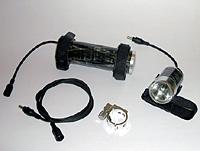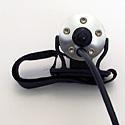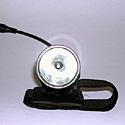
Recently on Cyclingnews.com |
Tech review - March 19, 2004
Lume Lighting Strada HID light
A little sun when you need it
By Paul Mirtschin

|
With the gain in endurance racing, in particular 24-hour races, riders are always on the lookout for brighter, tougher, longer-lasting, brighter and lighter lighting systems. And with the introduction of High Intensity Discharge (HID) lights, really really bright lights are becoming readily available.
The Strada HID by Lume Lighting is fairly bright, with its 10-watt lamp producing an intense beam equivalent to a 35 - 40 watt halogen light. But unlike a lot of HID lights that sacrifice burn time by using extraordinarily bright bulbs that give the light output of an 80 watt, the Strada provides a burn time of over 200 minutes. For most 24-hour courses, this lets you get a few laps in before you need a battery change.
Lume maximizes the fitment options of the Strada by providing both a machined aluminium bar mount and a plastic helmet mount. The lamp attaches to either mount with a single screw that makes swapping lights an easy proposition. The handlebar mount comes with two different sized rubber pads, so that you can select the best combination for proper fit on your bars. Unless you have some of the larger 31.8mm bars, but we will get to that later.
|
The lamp unit is a little bit heavy at 180 grams, but its beefy as all heck. Both the lamp and battery housings are made from filament wound composite materials with 6061 aluminium end caps - the only fragile part of the package is the front of the lamp and the rider.
Like most HID light systems, the Strada uses a Solarc lamp manufactured by Welch Allyn. Solarc lamps have an output of about 45 - 60 lumens for every watt of input power whereas Halogen lamps typically have an output of 15 - 20 lumens per watt. This gives the 10-watt Solarc lamp used in the Strada a 3.5 hour burn time from the 4.0 Ah, 9.6-volt NiMH battery pack while giving more than enough light to ride. Or to land aircraft.
Fitting the light is pretty much a no-brainer, you just need to decide if you want to bar mount the light or fit it to your helmet. The machined aluminium bar clamp and rubber fittings clamp securely to almost any bar, except for some downhill bars that are oversized right up to the point where your levers clamp. Unfortunately, two of my three bikes use these bars, so a lot of the review time was spend using the helmet mount either on a helmet, or slung below the stem; I knew having a square shaped stem would come in handy.
The 1.2-meter, water-resistant cable allows the battery to be mounted almost anywhere. The battery pack has two large rubber holders fitted with Velcro straps, and slinging it under a top-tube is a 20-second job. The battery extension cable's spring loaded clips keep the power flowing through, but as with all cables, if you catch it on something it will get dark fast.

|
Our light came with the fast charger, which fully charges the battery in under 3.5 hours. The charger uses a standard computer power cable, so it's easy to get a cable that will fit your local power sockets,and the charger will run from anything between 110 volts and 240 volts input. Once it's charged, the pack can be left trickle-charging indefinitely, so it's always topped up and ready for use.
We began the testing of this light with the usual "turn it on in the office" test. As the light warmed up from its dull blue glow to its bright 6000°K beam, we knew we had a bright light on our hands. On the commute home it was confirmed, with reflective street signs a kilometer away bursting into light. At least until the cable snagged on my pack, killing power to the light.
One downside of HID lighting systems is that you cannot just turn them back on. The lights need to cool down a bit before you re-strike them; not doing this will dramatically reduce the life of the lamp. A little wait for it to cool down, and it was time to make the darkness go away.
Although the Strada HID has a narrow beam, with the light mounted on the helmet and aimed where your eyes land naturally, there is enough spillover to light up the area just in front of your front wheel; this glow is more than enough to see with.
Once off the beaten track, and away from the city glow, these lights really come to life. The shadowy bushland around you is no longer something to be wary of, with all you can see being bathed in the glow of the Strada. And here we come to one of the problems with this light; bugs.
Most night dwelling insects are attracted to light, and mounted on my head was one of the brightest lights about. I caused bug genocide with this light, and most of them ended their lives on my face. They don't taste nice, and some of them hurt, but it hurt them more than it hurt me.

|
Because the lamp is quite heavy, putting it on your helmet puts a little more weight on your head than you expect. If you have a snug-fitting helmet, this is not a problem, but if your helmet moves around a bit, you will find the lamp adding to that movement. This happens with all head lamps to some degree though.
For all the testing with the lamp mounted to the helmet, I put the battery in a hydration pack. The long power-cable allowed the battery to be placed low in the pack where it will cause the least annoyance due to weight shifting. Any dense, heavy weight up high on the pack gets very annoying, very fast.
As a backup on a few of the first rides with the Strada, I took a lower-powered bar-mounted lamp, thinking the extra light would be useful; and found that each ride I was only using the light if I was behind a rider. If on my own or out in front, the HID was throwing more than enough light to render the 10W halogen lamp next to useless. An added bonus while commuting was that the light was bright enough to seemingly cause third-degree burns to any car driver that cut you off.
As far as lights for cycling go, HID lights such as the Strada are not cheap. But for anyone who does a lot of night riding, either in traffic or off-road, the added light and battery burn time is well worth the money. The Strada is one of the toughest lights I have encountered, with only a scratch on the battery case to show the light has been used; and that scar was acquired during a 12-hour race. I strongly suspect that the only maintenance this light will require is a new globe after it dies; and Solarc claim an average life of 1,000 hours for the globe so it is still a way off yet.
Recommended retail price: US$329 (fast charger), US$279 (overnight charger)
Weight: 800g
Pro: Bright, well constructed, long burn time.
Con: A little heavy; not cheap
Cyclingnews Rating: ![]()
More information: Lume
Lighting's website


